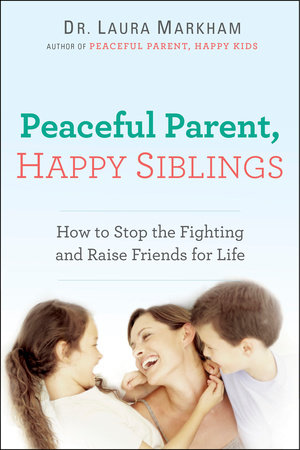Stop Fighting, Kids! Everyday Activities That Help Siblings Get Along
by Dr. Laura Markham
What types of activities promote sibling bonding? Almost any kind, as long as they meet three criteria:
- Each child enjoys the activity.
- The children enjoy interacting as they do the activity, so they experience warm feelings toward each other.
- The activity doesn’t stimulate feelings that fuel sibling rivalry. So, for instance, if the activity encourages the kids to compete, or worse yet, they feel they have to vie for the parent’s attention or approval, it undermines the sibling bond.
Siblings have better relationships when they share activities they both enjoy. It can be tough to identify those activities, especially if there’s an age or interest gap. But if you pay attention, you can usually suggest something that will interest both children. For instance, if she wants to play store and he wants to play astronaut, why not have a store on the moon?
Be sure to encourage at least one shared activity every day, and try not to interrupt happy play. You probably remember the old adage “Never wake a sleeping baby.” My corollary is “Don’t interrupt a happily playing child.” So when siblings are playing together well, don’t take it for granted. Support them in whatever they need to keep playing, and don’t interrupt unless it’s unavoidable.
Many parents discourage roughhousing, because they fear that someone will get hurt. But physical activity that gets kids laughing stimulates oxytocin, the bonding hormone, so it can be a fail-safe way to build closeness. And like other young mammals, when kids “play fight,” they learn to manage aggression, which makes them less likely to hurt each other when they’re angry. So when kids wrestle, pillow fight, and roughhouse, it’s good practice. Just help kids agree on ground-rules so everyone feels safe.
What if your children don’t seem to naturally settle into mutually enjoyable activities? Choose from these crowd-pleasers to get them playing together:
1. Reading. When the older child reads to the younger — even if he can’t actually read, but is “telling” the story — the older child feels more nurturing, and the younger child loves the positive attention, so friction is less likely.
2. Dancing, which is fun and connecting but gives kids at different levels their own autonomy.
3. Water play, which is soothing and inspiring all at once. Outside is better than inside, for obvious reasons.
4. Messy Art, which allows kids of different ages to engage differently.
5. Create a rain forest (or a similar project). Kids can draw pictures for the walls, create plants to hang from the ceilings, or make clay or paper mâché animals, depending on their age and skill levels.
6. Let your kids be in charge of a project together to build teamwork. For instance, maybe they’ll have a lemonade stand, or wash the car together. Or maybe they’re in charge of the decorations for Father’s Day, or planning a fun family outing. Let the children work together to do the planning, with you only peripherally involved to insure safety and maximum fun.
If your children can’t seem to play or work together without fighting, it’s time for you to step in. When tempers are short, reading is one of the best activities to shift the mood. Let each child choose a book, flip a coin to see which book goes first, and snuggle up with everyone while you read to them. Once everyone is feeling cozy, start your children interacting by asking questions about the story, and getting everyone involved in talking about what you’re reading.
To teach your children the skills to get along, regularly pull out an activity that everyone will like, such as making cookies, letting them dictate a story to you, or playing in the sprinkler. Stay involved to help the children express their needs without attacking each other and find solutions that work for both of them. It takes time to help kids learn to negotiate disagreements, but the investment in building those skills is worth it. Soon, you’ll be smiling from the other room as you hear your children giggling together as they play.
Reading aloud is a great bonding activity for the whole family. See Tips for Reading Aloud to More Than One Child.
-
Books by the Author
-


